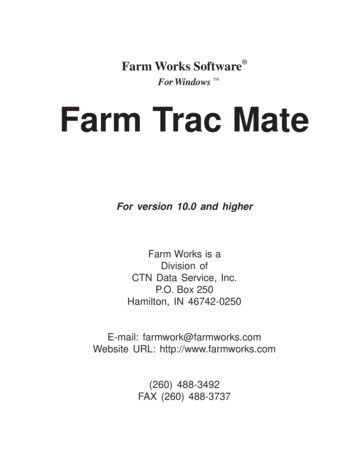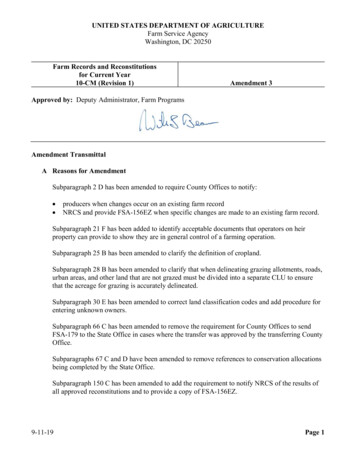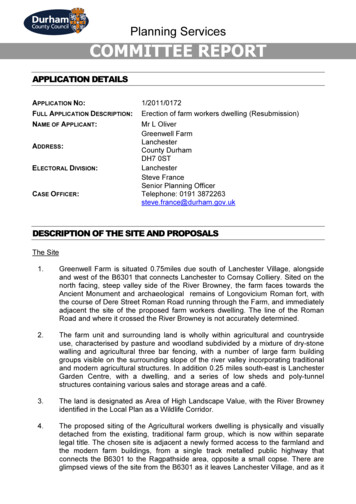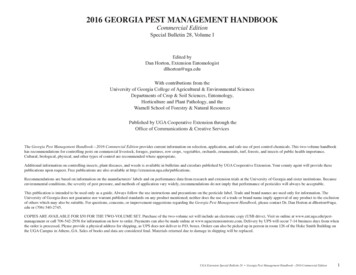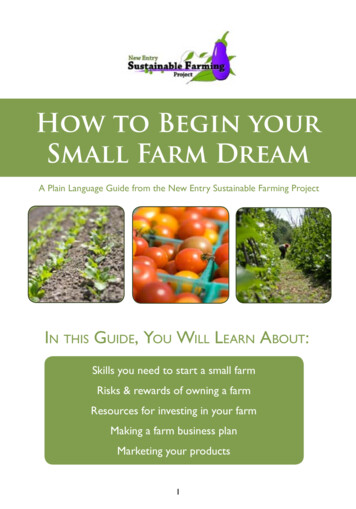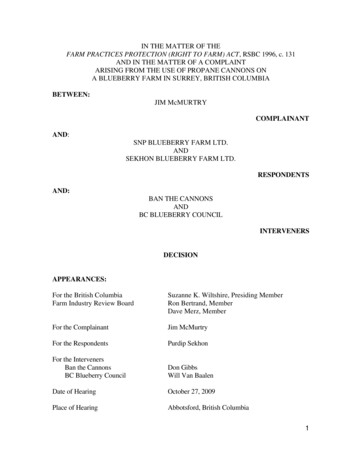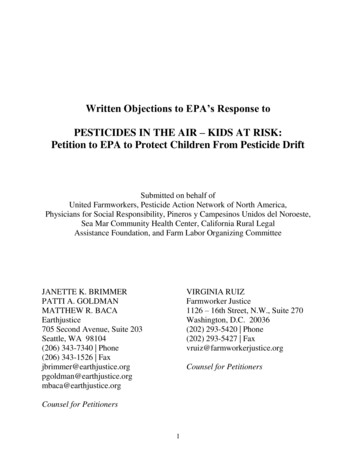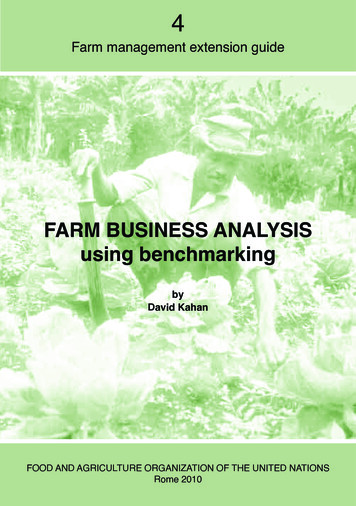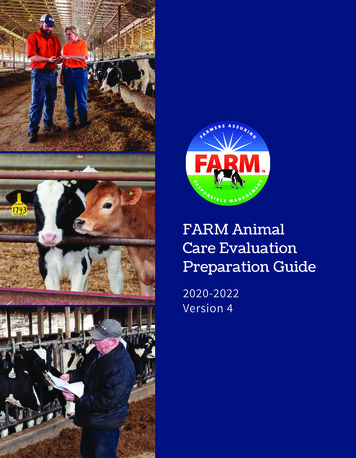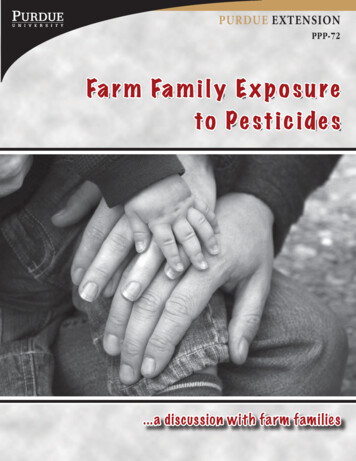
Transcription
Purdue ExtensionPPP-72Fa r m Fa m i l y E x p o s u ret o P e s t i c ide s.a discussion with farm familie s
Cover and other photographs purchased through fotolia.com unless otherwise indicated.
Farm Family Exposureto PesticidesA Discussion with Farm Familie sFred Whitford, Coordinator, Purdue Pesticide ProgramsJulia Storm, Agromedicine Information Specialist, North Carolina State UniversityAmy Mysz, Environmental Health Scientist, U.S. Environmental Protection AgencyBruce Alexander, Associate Professor, School of Public Health, University of MinnesotaJohn Acquavella, Senior Fellow, Epidemiologist, Monsanto Company, RetiredWayne Buhler, Coordinator, North Carolina Pesticide Safety Education ProgramCheri Janssen, Farmer, Tippecanoe CountyTom Neltner, Director of Training and Education, National Center for Healthy HousingCarol Burns, Epidemiologist, The Dow Chemical CompanyDiane Schmidt, Farmer, LaPorte CountyJack Mandel, Professor and Chairman, Department of Epidemiology, Emory UniversityArlene Blessing, Editor and Designer, Purdue Pesticide ProgramsIntroduction .5The Benefits of Using Pesticides .7Personal Concerns About Using Pesticides on the Farm . 10Are Pesticides Risky? . 11Toxicity: What Is It? . 13Exposure: How Much Are We Getting? . 16The Farm Family Exposure Study: Real World Exposures . 20What Does This Mean? . 26Reducing Exposures: What You Can Do . 26What Are Other Studies Finding? . 30Conclusion . 31Acknowledgments . 33Appendix . 343
4
IntroductionAs farmers and farmers’ spouses, you recognize the benefits ofusing pesticides in your crop and livestock operations, yet youmay be concerned about the possibility of adverse effects on yourfamily’s health and safety. This publication addresses questionsand concerns regarding pesticide risks and explains how risk isevaluated; it directs you to additional sources of information onpesticide toxicity. Data from the Farm Family Exposure Studyare reported, showing that farmers and their families who tooksimple precautions exhibited lower exposure levels than those whodid not. Steps to minimize pesticide risks around the farm areemphasized.5
6
The Benefits of Using PesticidesYou know that pesticides play an important role in your cropand livestock operations. You have witnessed the harm done byinsects, weeds, and diseases. Yields are reduced when your cropsmust compete with weeds for space, nutrients, and water. Fruitsand vegetables are blemished or damaged by insects and diseases,resulting in reduced market prices, rejection of products, or eventhe loss of an entire crop; diseased produce can lead to foodcontamination due to naturally occurring toxins (e.g., aflatoxin).Healthy food requires a healthy crop.Livestock producers know that cattle under stress from biting fliesdo not gain weight readily and that dairy cows produce less milkunder duress from nuisance flies. Neighbors may complain aboutlivestock operations drawing flies to their properties. Pesticidesprotect livestock and help maintain good community relationswhile increasing farm productivity and profitability.The benefits attributed to pesticides come with a significant pricetag. Thousands of dollars of your annual farm budget may beallocated for the purchase of pesticides, depending on the numberof cultivated acres, the crops grown, and pest pressure. The highcost of farming—and the low return on your dollar—causes youto analyze the economics of pesticide use versus the adoptionof practices to reduce the need. You must continually reevaluatethe return on your investment in crop- and livestock-protectionchemicals.No doubt you believe in sustainable agriculture and evaluate yourproduction practices accordingly. You respond to consumer demandby implementing environmentally sound practices to produce safe,healthy foods. You want to leave the legacy of an ecologically sound,productive farm to your children.7Fred Whitford.leave the legacy ofan ecologically sound,productive farm toyour children
8
Many of you use nonchemical pest management methods wheneverpossible; but if a pesticide is required, you try to use the lowesteffective application rate to demonstrate good stewardship andsave money. When the application rate is lowered, less chemical isused and dollars are diverted from the farm to the family.Farmers are increasingly cutting back or eliminating certainpesticide uses by adopting integrated pest management and othersustainable-agriculture practices. These include planting insectresistant crops to minimize insecticide use, planting narrowerrows to reduce weeds, planting disease-resistant varieties, rotatingcrops to disrupt disease cycles, leaving buffer strips to protectstreams, and rotating the use of pastures for grazing. Nonetheless,pesticides continue to play an important role in managing pests,especially those emerging as serious threats to livestock or crops(e.g., soybean rust, left). Pests always have been and always will bea threat to the food supply and farmers’ profit.Soybean RustSoybean rust is a foliar disease that can quickly defoliate plants. Airborne spores land onsoybean leaves and, in the presence of dew, germinate and infect. About 9 days later, pustulesdevelop on the underside of the leaf blade (inset, left). Individual pustules are small andproduce many spores. A severely infected leaf may contain hundreds of pustules. At this stage,the leaf will turn yellow and drop from the plant (left). The fungus is a parasite. As it grows andproduces spores on the leaves, it diverts nutrients from the soybean plant that would otherwisego into seed production. Yield reductions from rust can be substantial, as much as 80 percent.All varieties of soybean suitable for production in the U.S. are susceptible to rust; planting date,tillage, and crop rotation have no effect on it. Application of a foliar fungicide is the only meansof control. There are several fungicides that will provide effective control if applied at the righttime. Application just before infection gives best control, but application when infection isstill at a very low level in a field is also effective. A “very low level” means rust is on no morethan 5 percent of the leaves in a field. At this low incidence of infection, most infected leaveswill have only one or two pustules. Detection of such a low incidence of disease is difficult.Growers should keep in touch with county extension offices for the latest information onsoybean rust, including spray recommendations, during the growing season. County extensionstaff and campus specialists will monitor rust development in the southern U.S. (the sourceof airborne spores for the Midwest), weather conditions, and sentinel plots throughout thestate in order to advise growers on what actions they need to take to manage this disease.Photographs and soybean rust information compliments of Dr. Gregory Shaner, Department of Botany and Plant Pathology,Purdue University.9Tim McCabe, NRCS, IowaScouting isan importantcomponent ofIntegrated PestManagement
Personal Concerns AboutUsing Pesticides on the FarmAs a farmer, you are well aware of the benefits of pesticides; but youmay be less knowledgeable on the human health effects pesticideuse can impose. Consider these questions: Do pesticides get on or into our bodies? Are pesticides harmful to us? Can we prevent pesticide exposure?You no doubt hear news stories that raise concerns about theharmful effects of pesticides on human health. Expert opinion isdivided and passionate: some say there is much risk; others saythere is little. The bottom line is, there is always some level of riskassociated with pesticide use.Do pesticides get onor into our bodies?10
It is unsettling to recognize the need to use pesticides despite youruncertainty about possible effects on your family’s health. It is welldocumented that pesticides are handled differently from one farmto the next. Some farmers wear chemical-resistant gloves whenhandling pesticides; some do not. Some farm children help withpesticide applications; others do not. Some farmers pour pesticidesdirectly into the sprayer; others do not. Some use large quantities;others do not. The answers to pesticide safety questions are directlyrelated to how you handle the chemicals.Are Pesticides Risky?The health risk associated with any chemical product is a functionof its toxicity and the extent of exposure; simply stated, pesticiderisk equals toxicity times exposure. Therefore, understandingtoxicity is important; and it is critical to consider the amount towhich you are exposed, the length of time you are exposed, andthe way you are exposed (i.e., by ingestion, inhalation, or dermalabsorption).Another way of looking at this relationship is to consider the cancerrisk from radiation. Like pesticides, radiation is derived from manysources. It is present in the ultra-violet (UV) rays from the sun, inmedical X-rays, and in radon gas emitted from naturally occurringmetals in the earth. Radiation causes some types of cancer. Thevarious types of radiation are toxic in varying degrees—x-raysare extremely harmful, while UV rays are less harmful—and thetype of radiation exposure determines the type and severity of itsharmful effects. Minimizing exposure by spending less time in thesun or tanning booth, limiting the number of chest x-rays you have,and making sure your home is protected from radon is importantin reducing your cancer risk.Are pesticides11harmful to us?
Pesticide Risk Toxicity x ExposureYOU ControlExposurePesticide risk equals toxicity times exposure. Your personal riskfrom a pesticide depends on the toxicity of the product you areusing and the amount and form of exposure you experience;likewise for each member of your family. The lower the toxicityand/or exposure, the lower the risk. Choose pesticides with lowtoxicity whenever possible, and always minimize exposure bywearing protective clothing.Risk, to the scientist, is a continuum from low to high—not anabsolute. Scientists and government officials address risk in termsof probability for populations or individuals. The critical questionis whether the risk is real to you, to the people you care about, or tothe things you value in nature and society.Certain farm pesticide use activities are riskier than others. Forexample, pouring a pesticide concentrate into the spray tank isriskier than walking into the treated field to scout for insects; thatis, exposure to the concentrate is more likely than contact withthe treated crop to cause personal health effects. The level of riskassociated with handling concentrates is lessened if the handlerwears a long-sleeved shirt, gloves, and goggles; and using a transferhose to move the pesticide directly from the minibulk container tothe sprayer is a significantly safer procedure than pouring.Fred WhitfordGlovesGogglesLong SleevesLong PantsChemical-ResistantFootwear12
Research demonstrates that your degree of personal exposure isdirectly related to how you handle a pesticide. Your risk potential—and your family’s—can be dramatically reduced by using safetyprecautions and following label directions.Toxicity: What Is It?Scientists have known for centuries that virtually every chemical,both natural and synthetic, is toxic enough at some level to causeadverse effects. Knowing that precise level of toxicity is importantin assessing risk. A small amount of one pesticide might produce atoxic effect, while a much larger amount of another may not. But,at some level, every pesticide has a toxic effect; the same is true formedicines, table salt, gasoline, and household cleaners. The routeof human exposure impacts the toxic effect.The toxicity of a pesticide must be evaluated before it can beregistered and sold in the United States. The U.S. EnvironmentalProtection Agency (EPA) requires pesticide manufacturers toconduct numerous toxicity tests to determine the potential effectsof each pesticide. Scientists conduct laboratory animal exposurestudies to assess toxicity, using various doses of individual pesticidesand formulated products. These tests include studies on chronic(long-term) effects such as cancer and reproductive problemsas well as studies on acute (immediate) effects. EPA reviews thetoxicology and use data for each pesticide. EPA also reviews themanufacturers’ safety requirements and precautions for the labelsof individual products.As science advances, EPA considers whether additional tests areneeded to evaluate potential problems from the use of pesticides.The recent requirement that manufacturers test pesticides for theirability to mimic human hormones is an example. The process isunderway to determine the best way to perform the testing, but itmay take the scientific community years to reach a consensus.13Your degree ofpesticide exposure is areflection of how youhandle the pesticide
It is important to remember that each pesticide is unique. Everypesticide product used on the farm has its own level of toxicity.Therefore, answers to questions about toxicity must be based onindividual pesticide I thought Mom andDad were smarterthan that!The toxicity of every pesticide is listed on the label. Look for thesignal word—CAUTION, WARNING, or DANGER—andread all of the information provided. The Material Safety DataSheet (MSDS) for each product addresses toxicity and humanhealth, as do various Web sites.The Label on the Pesticide Container. The signal word ona pesticide label indicates the level of acute (short-term) toxiceffects that may occur within the first day or two of exposure.Acute toxic effects generally are associated with brief exposuresto chemicals and may include headaches, skin irritation, burns, oreven death. The signal word printed in large letters on the front ofthe label indicates the level of toxicity: CAUTION (low toxicity),WARNING (moderate toxicity), or DANGER (high toxicity).Another important part of the label is product classification.Restricted-use product labels display the words restricted usepesticide above the brand name at the top of the front panel.There is no designation on the labels of general-use products; thatis, if the label does not say restricted use pesticide, then it is ageneral use product. Products can be restricted due to either healthor environmental concerns.You must pass a state certification exam to purchase and applyrestricted-use pesticides, and your agricultural chemical dealershould ask to see your private applicator certification card beforeselling them to you. Restricted-use products are more toxic thangeneral-use products, but be aware that a poorly handled generaluse product might pose more risk than a restricted-use productthat is handled cautiously.14
The Material Safety Data Sheet and Other Toxicity DataSources. The MSDS can be accessed from your local agriculturalretailer, the product manufacturer, or the Internet. The MSDS willindicate if tests have shown that the product can cause health effects,including chronic long-term health problems such as birth defects,cancer, or liver disease. Most chronic toxicity data on human healthcome from animal studies. If occupational epidemiology studies inpesticide manufacturing facilities show adverse effects, those alsomay be represented on the MSDS. The Web sites listed below alsocontain chronic toxicity information: http://www.epa.gov/pesticides/factsheets/chemical fs.htm http://extoxnet.orst.edu/ghindex.html http://www.atsdr.cdc.gov/toxfaq.html http://www.aghealth.org http://toxnet.nlm.nih.govIn Review:The Take-Home Message Every pesticide product istoxic at some level. The more toxic the pesticide,the smaller the amount it takesto cause a health problem. The toxicity of every pesticide product soldin the United States is tested extensively. The signal word on the label alerts you tothe short-term toxicity of the product. The MSDS provides information onpotential long-term health problems.15
Exposure:How Much Are We Getting?I’ve never worriedmuch about exposingmyself to pesticides.I’ve worked with themfor years and theyhaven’t hurt me. ButI never realized that Icould carry pesticidesinto the house on myclothes and boots andexpose my FAMILY.You and your family are exposed to household cleaners when youclean house and to diesel fuel when you fill the tractor, truck, orcombine; but the risk is small. Likewise, there is some degree ofexposure and risk every time you use a pesticide. A splash ontounprotected skin while pouring a pesticide or diluting it with watercan cause dermal exposure. You may experience direct exposure byinhaling pesticide droplets in an open cab or making contact withthe spray mix while repairing clogged nozzles. Indirect exposureis a risk when walking through a treated field, or from touchingpesticide-contaminated clothing; and pesticide residues can betracked into the home on shoes and boots. How much exposure isharmful? It depends on the product’s toxicity, the type of exposure,and your individual sensitivity.How Do ScientistsMeasure Exposure?Scientists use several ways to evaluate pesticide exposure, dependingon resources and time available, practicality, cost, and willingnessof participants.Estimating Exposure Based on Memory of Past Use. Scientistsoften study the human health effects of pesticides by surveyingpeople who have used them and identifying specific use conditions.Survey questions may ask about uses that occurred far enough inthe past that exposure cannot be directly measured, or they may askabout uses that occurred in the recent past. Someone who reportsusing a pesticide repeatedly might be considered more highlyexposed than a person who reports minimal use. Surveys may ormay not include questions on safety precautions such as wearing16
gloves when handling pesticides, but inclusion of such informationimproves the exposure estimate.Surveys are less costly and less intrusive than measurement studies,but they have limitations. For example, it is often difficult to verifythe accuracy of self-reported exposure, especially when estimatingexposure to a specific product or formulation used many years ago.These studies often set the stage for more elaborate studies thatexamine exposure in more detail.External Exposure Based on Measuring Pesticide Residues.MonsantoAnother common method for estimating human exposure is tomeasure the amount of pesticide on clothing or skin, or within thebreathing zone of the applicator. Patches are placed on the clothesand caps, on either the inside or outside, where they trap residuesthat reach them. At the end of the exposure period, usually awork day, the patches are analyzed in a laboratory. The amount ofpesticide on each patch represents a portion of the amount on thecorresponding region of the body. Rinses and wipes are used tomeasure pesticide residues on the hands, face, and neck. Personalair samplers are used to estimate the amount of pesticide that theapplicator inhales. These external measurements allow scientiststo determine the maximum amount of pesticide exposure for theindividual.MonsantoMeasuring the amountof pesticide on clothing(left) and on hands(above).17
Scientists can estimate internal exposure based on externalmeasurements by making certain assumptions about how muchof the pesticide was absorbed into the body. For example, pesticideresidues on an applicator’s clothing following an application orafter walking through a treated field are measured; based on thetotal amount, chemists estimate how much pesticide penetratedthe applicator’s clothes and may have been absorbed by the skin,thereby entering the bloodstream. These exposure estimatesare compared with amounts known to cause health problems inlaboratory animals.This type of study also has limitations. It cannot be determinedby the patch method exactly how much pesticide enters the bodysince some amount remains on clothing, some may reach the skinbut fail to penetrate it, and some may be ingested through nailbiting, smoking, etc. Although patch sampling is not personallyintrusive, it is time-consuming for participants and field scientists,and analyses are costly.How carefulare you?Measuring Pesticides in Urine and Blood. Scientists evaluatewhether a person has been exposed to a pesticide by measuringits presence in their blood or urine. Pesticides move through thebloodstream into various internal organs. They are filtered fromthe bloodstream by the liver and kidneys and expelled in urine andfeces. Few modern pesticides accumulate in the body (i.e., they arenot stored in fat), so blood and urine samples should be taken theday of exposure.Many pesticides metabolize (break down) into other compounds inthe body, and it is these substances—not the pesticides themselves—that can be detected in blood and urine. Animal studies have shownhow much of and how quickly a chemical moves through the bodyand is excreted, and scientists apply that information to estimatehuman exposure levels based on measurements taken from urinesamples. Internal exposure studies have few scientific limitations,18
but they are the most costly for funding agencies and the mostintrusive for participants.Combining Measurement Studies with Observation. Measurement studies often include observation of the applicator duringmixing, loading, and application. Objective notes and video providevaluable documentation of conditions under which pesticideapplication, exposure, and spills occur. Blood and urine samples, incombination with field observation data, provide our best insightinto the amounts of exposure associated with various pesticiderelated activities: mixing, loading, application, and cleanup ofspills. Pesticide measurements are matched with the circumstancesof exposure, which helps in defining precautions that can betaken to prevent future exposures. The Farm Family ExposureStudy, discussed later in this publication, used internal exposuremeasurements and observation to evaluate farm family exposure tothree commonly used pesticides.Safety is in Your HandsThe risk you face when applying a pesticide is a factor of toxicityand exposure; it depends on how toxic the pesticide is, the route ofexposure, and the quantity to which you are exposed. Obviously, thehigher the exposure, the higher the risk; but you can take actions tominimize exposure and reduce the risk.The pesticide label provides critical information on how tominimize risk while using the product. Always read all precautionsand wear safety equipment as instructed on the label; theserecommendations are based on toxicity studies and applicationspecific exposure data. Restricted-use products with labels bearingthe signal word warning or danger require more safety gear andprecautions than less toxic products labeled caution. The FarmFamily Exposure Study documented that taking safety precautionshelps reduce exposure and risk in real world farm situations.19Sometimes, what wetouch finds its wayto our mouths
In Review:The Take-Home Message Exposure and toxicity arecritical in defining risk. It is difficult to measure a person’spesticide exposure. Reducing exposure reduces health risk.The Farm Family ExposureStudy: Real World ExposuresThe Farm Family Exposure Study was designed to answer twobasic questions: How much pesticide exposure do farmers and their familiesexperience from a typical pesticide application on their farm? What practical measures can be taken to lessen pesticideexposure?The University of Minnesota School of Public Health conductedthe study with funding provided by a group of pesticidecompanies.20
Ninety-five farm families in South Carolina and Minnesotavolunteered to participate under the following eligibilityrequirements: The family included a farmer, spouse, and at least one childbetween the ages of 4 and 17. All participating family members lived on the farm. The farmer had to apply glyphosate (Roundup or its genericformulation), chlorpyrifos (Lorsban granules or liquid) or2,4-D (liquid) to at least ten acres within one mile of the farmhome.Farmers and spouses completed two questionnaires, one beforeand one after the pesticide application. The questionnaires askedfor personal data and farming history as well as information onapplication practices and recent pesticide use. Each farmer, spouse,and child was required to collect his or her entire urine output forfive consecutive days: the day before the pesticide application, theday of the application, and the three days following the application.Methods used to test the urine were capable of detecting pesticideconcentrations as low as one part per billion, which can beapproximated to one blue kernel of corn among a billion yellowkernels.21
Study ResultsAn important element of the Farm Family Exposure Study wasthe measurement of pesticide absorption (internal exposure);equal focus was given to all members of the participating families.Resulting levels of absorption were matched with responses tosituation-specific questions such as, Was safety equipment worn?and Did family members help with the handling process? Thecorrelation helped identify procedures you and your family mightuse to reduce or limit pesticide exposure.Were pesticides absorbed by the body? The answer was yes formost farmers and their families (Table 1). Farmers averagedhigher concentrations of pesticides in their urine than did theirspouses and children. Most spouses and children had very low orno detectable levels, but a few of the children did have detectablelevels. Overall, results show that pesticides were absorbed by the body.Table 1. Measured levels (parts per billion) of three commonly usedpesticides in the urine of applicators, spouses, and childrenLiquid and ageRangeAverageRangeAverageRange3 1–233642–2236194–304Spouses 1 1–21 1–2051–35Children 1 1–294 1–64081–11922
Table 2 shows the percentage of farmers, spouses, and childrenwhose urine contained detectable levels of certain pesticides. Thedata demonstrate that some agricultural chemicals impact exposureestimates more than others, and that pesticide use impacts the farmfamily as well as the farmer.Table 2. The percentage of applicators, spouses, and children withdetectable amounts of pesticides in their urineGlyphosate2,4-DLiquid and GranularChlorpyrifosPercent DetectionPercent DetectionPercent catorsAre you doin’ allthe right things,Dad?Responses to questions, along with information taken by studyobservers, revealed that certain actions—or inactions—markedlyinfluenced the level of internal exposure (Appendix 1). It wasapparent that certain practices lead to high applicator exposure; forinstance, consider the activities and behaviors of the farmer whoseurine had the highest level of glyphosate (233 parts per billion). Astudy observer noted the following:Yes No Did the farmer wear gloves when mixing? 4 Did the farmer spray from within an enclosed cab? 4 Did the farmer have a spill during the mixing process? 4 Did the farmer have a spill during application?4 Did the farmer have skin contact with the pesticide?4 Did the farmer repair equipment without glovesduring application?4 Did the farmer use a closed system (e.g., minibulk)? 4 Did the farmer smoke during the mixing or sprayingprocess?4 Did the farmer eat during the mixing or loadingprocess? 423
The answers indicate that failing to take precautions—e.g., notwearing gloves, not using enclosed cabs, not avoiding spills—leadsto increased absorption of pesticides into the body. Observationsshow that taking some but not all precautions also can lead tosignificant exposure, as in the case of the farmer whose 2,4-D leveltested the highest. The following information was gleaned from astudy observer’s notes:Yes No Did the farmer wear gloves? 4 Did the farmer spray from within an enclosed cab?4 Did the applicator have a spill during the mixingprocess? 4 Did the farmer have a spill during application?4 Did the farmer have skin contact with the pesticide?4 Did the farmer repair equipment without glovesduring application?4 Did the farmer use a closed system (e.g., minibulk,Lock and Load)?4 Did the farmer smoke during the mixing or sprayingprocess? 4 Did the farmer eat during the mixing or loadingprocess? 4You’re tellin’ me youdidn’t even wear gloves?Even though the farmer rode in an enclosed cabdur
The health risk associated with any chemical product is a function of its toxicity and the extent of exposure; simply stated, pesticide risk equals toxicity times exposure. Therefore, understanding . the things you value in nature and society. Certain farm pesticide use activities are riskier than others. For example, pouring a pesticide .
